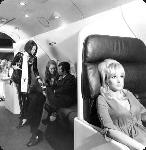Фотографии
-
Регистрационный номер: N950PB [17] This beautifully evocative photograph by JON PROCTOR was taken as factory-fresh DC-9 N950PB crossed Lakewood Boulevard at the McDonnell Douglas plant at Long Beach, California, in January 1969. All aircraft coming off the production line had to cross this street to begin pre-flight and flight testing.
Самолёты на фотографии: McDonnell Douglas DC-9 - США - 1965
-
Регистрационный номер: N950PB [17] The Big Bunny taxies in at London Heathrow on July 29, 1970, on its first trip to Europe.
Самолёты на фотографии: McDonnell Douglas DC-9 - США - 1965
-
Регистрационный номер: N950PB [17] The Big Bunny over the California mountains.
Самолёты на фотографии: McDonnell Douglas DC-9 - США - 1965
-
Регистрационный номер: N950PB [17] “Hare Force One” at Los Angeles International Airport in October 1974. The aircraft’s cockpit was modelled after the configuration used by Eastern Airlines. The navigation equipment - including Doppler and Loran instrumentation - followed the example of the United Airlines fleet.
Самолёты на фотографии: McDonnell Douglas DC-9 - США - 1965
-
Регистрационный номер: N950PB [17] On arrival at the gate, Hef and his black-clad Jet Bunnies greeted the British press.
Самолёты на фотографии: McDonnell Douglas DC-9 - США - 1965
-
Регистрационный номер: N950PB [17] Hugh Hefner’s “Big Bunny” - DC-9 N950PB
Самолёты на фотографии: McDonnell Douglas DC-9 - США - 1965
-
Регистрационный номер: N950PB [17] Самолёты на фотографии: McDonnell Douglas DC-9 - США - 1965
-
Регистрационный номер: N950PB [17] The epitome of the jet set lifestyle, the Big Bunny set the gold standard for the private jetliner, no expense being spared to provide the ultimate experience in firstclass travel. Even the food cart was specially designed to keep food warm. The cabin was soundproofed with a dual layer of lead vinyl on the inside of the fuselage skin.
Самолёты на фотографии: McDonnell Douglas DC-9 - США - 1965
-
Регистрационный номер: N950PB [17] The cabin was provided with Koss headphones for the private enjoyment of music, and was also fitted with a duplicate altimeter, airspeed indicator and compass for guests to follow the flight plan.
Самолёты на фотографии: McDonnell Douglas DC-9 - США - 1965
-
Регистрационный номер: N950PB [17] A guest aboard the Big Bunny adjusts her make-up in the sculpted powder room on the port side of the cabin, forward of the living-room area.
Самолёты на фотографии: McDonnell Douglas DC-9 - США - 1965
-
Регистрационный номер: N950PB [17] Lee Fehlig, at the controls of the entertainment console in the “Living Room” of the DC-9, adjusts the volume of the Sony eight-track stereo cartridge player. Beneath the television is the Ampex 660 video tape machine that played pre-recorded colour programmes on the seven TV screens located throughout the jetliner.
Самолёты на фотографии: McDonnell Douglas DC-9 - США - 1965
-
Регистрационный номер: N950PB [17] Jet Bunny Britt Elders demonstrates the emergency procedure for the oxygen masks in the event of cabin decompression at cruising altitude.
Самолёты на фотографии: McDonnell Douglas DC-9 - США - 1965
-
Регистрационный номер: N950PB [17] Anne Denson, selected from the Chicago Playboy Club to be a Jet Bunny, prepares a stiff one at the bar in the forward part of the DC-9’s living-room area.
Самолёты на фотографии: McDonnell Douglas DC-9 - США - 1965
-
Регистрационный номер: N950PB [17] Hefner’s all-important 6ft x 8ft elliptical bed, the accommodation of which was a crucial factor in determining the chief playboy’s choice of aircraft. The bed was covered with a spread of Tasmanian opossum.
Самолёты на фотографии: McDonnell Douglas DC-9 - США - 1965
-
Регистрационный номер: N950PB [17] A carefully posed series of publicity photographs was taken to reflect Hef’s vision of duplicating the luxurious ambience of the Playboy Mansion in Chicago.
Самолёты на фотографии: McDonnell Douglas DC-9 - США - 1965
-
Регистрационный номер: N950PB [17] Hef and his then-girlfriend, Barbi Benton, star of the syndicated TV show Playboy After Dark.
Самолёты на фотографии: McDonnell Douglas DC-9 - США - 1965
-
Регистрационный номер: N950PB [17] Looking forward into the Bunny’s living-room area.
Самолёты на фотографии: McDonnell Douglas DC-9 - США - 1965
-
Hugh Hefner (right) is talked through a model of the proposed layout of the “Big Bunny” by Daniel Czubak, the designer of the jetliner’s interior. At the time, the Playboy DC-9 was by far the largest and most luxurious private aircraft in existence and Hefner’s role in setting the standard for the corporate jet is often overlooked.
Самолёты на фотографии: McDonnell Douglas DC-9 - США - 1965
-
A plan view of the layout of the Playboy DC-9, which was divided into three distinct sections: a forward section for conferences and meetings; the living-room area and Hefner’s quarters at the rear.
Самолёты на фотографии: McDonnell Douglas DC-9 - США - 1965
Статьи
- -
- American Classics
- Off the Beaten Track...
- ??? - Surprise, surprise!
- D.Moore - Ryan and the triangular pterodactyls
- D.O'Connor - Flying the Furrow
- G.Warner - To Belfast via Calcutta
- G.Warner - Why was the "Bristol" Mercury so long lived?
- J.Forsgren - Northern exposure
- J.Pote - From Penthouse to Workhorse
- M.Oakey - Out of the blue
- M.O'Leary - The tragedy of Flight Three
- N.Stroud - Hef and the Big Bunny
- N.Stroud - Messerschpitts at five o'clock!
- P.Brooks - One furious summer
- P.Jarrett - Under the windstocking


















